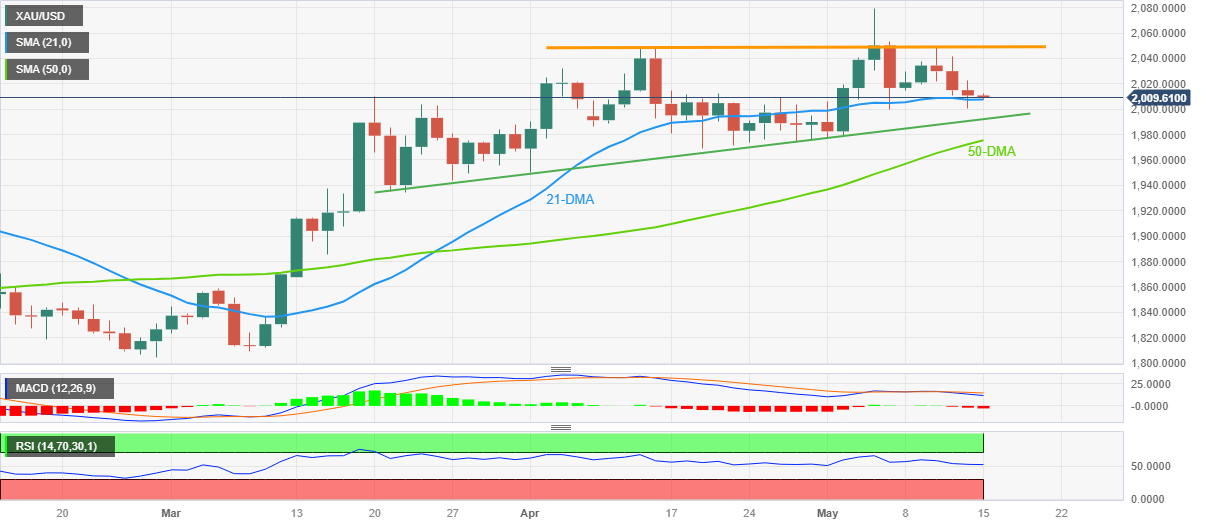- Analytics
- News and Tools
- Market News
- Gold Price Forecast: XAU/USD bears cheer United States debt ceiling deadlock, banking woes
Gold Price Forecast: XAU/USD bears cheer United States debt ceiling deadlock, banking woes
- Gold price remains pressured towards short-term key support after snapping two-week winning streak.
- Risks emanating from the United States debt ceiling expiry, banking woes underpin US Dollar rebound and weigh on XAU/USD price.
- Gold price fails to cheer softer US inflation clues Federal Reserve bets suggesting policy pivot.
- US Retail Sales, Fed Chair Powell’s speech and debt ceiling drama will be crucial to watch for XAU/USD direction.
Gold price remains depressed around $2,010 as it seeks fresh clues to extend the three-week downtrend, especially after posting the first weekly loss in three. In doing so, the yellow metal portrays the market’s anxiety amid the United States debt ceiling jitters, as well as the banking fears. However, a light calendar and mixed updates from the Federal Reserve (Fed), as well as the US government officials, prod the XAU/USD bears ahead of this week’s key data/events.
Gold price drop on United States debt ceiling drama, banking woes
Gold price bears the burden of concerns that the US may default in early June if the debt ceiling isn’t altered soon. The same seems to weigh on the market sentiment and underpin the US Dollar’s run-up. On the same line were fears emanating from the US banks as some of the mid-tier ones posted heavy drawdowns in share prices and deposits in the last week.
Further, hawkish comments from the Federal Reserve (Fed) officials also weigh on the XAU/USD. That said, Fed Governor Philip Jefferson and St. Louis Fed President James Bullard defend the US central bank’s current monetary policy while citing higher inflation as a major challenge. On the same line, Federal Reserve (Fed) Governor Michelle Bowman said Friday, “policy rate will need to remain sufficiently restrictive for some time.”
Recently, US President Joe Biden signaled that Friday’s delayed talks will be held on Tuesday. The same joins comments from US Treasury Secretary Wally Adeyemo who termed the debt-ceiling negotiations between the White House as "constructive," to challenge the market pessimists and the US Dollar buyers. As a result, the Gold price remains depressed but the bears take a breather of late.
Softer US data fails to impress XAU/USD buyers
While the aforementioned catalysts weigh on the Gold price, the softer US inflation clues and downbeat data from other fronts fail to defend the XAU/USD price. On Friday, preliminary readings of the University of Michigan's (UoM) Consumer Confidence Index for May dropped to 57.7 from 63.5 prior versus 63.0 market forecasts. More interestingly, the one-year inflation expectations dropped from 4.6% to 4.5% for the said month but 5-year counterpart rose to the highest reading since 2011, from 3.0% to 3.2%.
Risk catalysts are the key for clear Gold price directions
Looking ahead, Tuesday’s US debt ceiling talks will be the key for the Gold traders to watch for immediate directions. Following that, US Retail Sales and a speech from Fed Chairman Jerome Powell should be eyed closely.
Should the US policymakers fail to extend the debt ceiling, the Gold price may have a further downside to trace. Further, upbeat US data and hawkish comments from Fed’s Powell can also help the XAU/USD bears.
Gold price technical analysis
Gold price portrays a bearish triangle formation on the Daily chart, currently between $2,050 and $1,990. That said, the bearish signals from the Moving Average Convergence and Divergence (MACD) indicator, as well as the steady Relative Strength Index (RSI) line, placed at 14, also suggest further downside of the XAU/USD.
However, a clear break of the $1,990 support becomes necessary for the Gold price to aim for the theoretical target of around $1,875.
It’s worth noting, that the 21-DMA, near $2,007 by the press time, acts as an immediate support for the Gold price whereas the 50-DMA surrounding $1,972 and the $1,900 round figure may act as an intermediate halt for the XAU/USD between $1,990 and $1,875.
Alternatively, a daily closing beyond the $2,050 will defy the bearish triangle formation on the Gold price, a break of which could quickly propel the XAU/USD towards the previous yearly high of around $2,070 and then to the latest record-high of near $2,080.
Following that, the $2,100 round figure may act as an extra check for the Gold buyers.
Gold price: Daily chart

Trend: Further downside expected
© 2000-2024. All rights reserved.
This site is managed by Teletrade D.J. LLC 2351 LLC 2022 (Euro House, Richmond Hill Road, Kingstown, VC0100, St. Vincent and the Grenadines).
The information on this website is for informational purposes only and does not constitute any investment advice.
The company does not serve or provide services to customers who are residents of the US, Canada, Iran, The Democratic People's Republic of Korea, Yemen and FATF blacklisted countries.
Making transactions on financial markets with marginal financial instruments opens up wide possibilities and allows investors who are willing to take risks to earn high profits, carrying a potentially high risk of losses at the same time. Therefore you should responsibly approach the issue of choosing the appropriate investment strategy, taking the available resources into account, before starting trading.
Use of the information: full or partial use of materials from this website must always be referenced to TeleTrade as the source of information. Use of the materials on the Internet must be accompanied by a hyperlink to teletrade.org. Automatic import of materials and information from this website is prohibited.
Please contact our PR department if you have any questions or need assistance at pr@teletrade.global.















